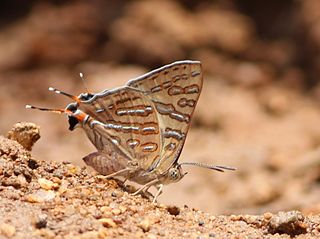Related Research Articles

Halpe homolea, the Indian ace or Ceylon ace, is a butterfly belonging to the family Hesperiidae.

Telicota colon, commonly known as the pale palm dart or common palm dart, is a butterfly belonging to the family Hesperiidae found in India to Australia.

Bindahara phocides, the plane, is a small butterfly found Indomalayan and Australasian realms that belongs to the lycaenids or blues family.

Arhopala amantes, the large oakblue, is a species of lycaenid or blue butterfly found in Asia.

Arhopala abseus, the aberrant oakblue or aberrant bushblue, is a species of lycaenid or blue butterfly found in Asia.

Arhopala atrax, the dark broken-band oakblue or Indian oakblue, is a species of lycaenid or blue butterfly found in the Indomalayan realm.

Arhopala centaurus, the centaur oakblue or dull oakblue, is a species of lycaenid or blue butterfly found in India and southeast Asia to the Philippines.

Cigaritis abnormis, the abnormal silverline, is a species of lycaenid or blue butterfly found in south India and Pakistan.

Zesius chrysomallus, the redspot, is a species of lycaenid or blue butterfly found in Sri Lanka and India.

Tajuria jehana, the plains blue royal, is a species of lycaenid or blue butterfly found in Asia.

Virachola isocrates is a species of lycaenid or blue butterfly found in Asia. Its common names include common guava blue, pomegranate butterfly, and anar butterfly. It is a pest of pomegranates in India.

Virachola perse, the large guava blue, is a species of lycaenid or blue butterfly found in the Indomalayan realm. It was described by William Chapman Hewitson in 1863. The larva feeds on Randia dumetorum.

Rapala varuna, the indigo flash, is a species of lycaenid or blue butterfly found in the Indomalayan realm and the Australasian realm.

Rathinda is a butterfly genus in the family Lycaenidae. It consists of a single species, Rathinda amor, the monkey puzzle, found in Sri Lanka and India.
Psilocerea vestitaria is a species of moth of the family Geometridae first described by Charles Swinhoe in 1904. It is found on Madagascar.
Psilocerea dysonaria is a species of moth of the family Geometridae first described by Charles Swinhoe in 1904. It is found on Madagascar.

Cigaritis lohita, the long-banded silverline, is a species of lycaenid or blue butterfly.
Syngamia oggalis is a moth in the family Crambidae. It was described by Charles Swinhoe in 1906. It is found in Meghalaya, India.
Syllepte venustalis is a moth in the family Crambidae. It was described by Charles Swinhoe in 1894. It is found in Meghalaya, India.

The Common shot silverline, Cigaritis ictis, is a species of lycaenid butterflies. It is native to India and Sri Lanka. The Sri Lankan population is classified as a subspecies: Cigaritis ictis ceylonica(Felder, 1868).
References
- ↑ De Prins, J. & De Prins, W. (2018). "Psilocerea anearia Swinhoe, 1904". Afromoths. Retrieved April 8, 2019.
- ↑ Swinhoe (1904). "Transactions of the Entomological Society of London".Cite journal requires
|journal=(help)
| | This Ourapterygini-related article is a stub. You can help Wikipedia by expanding it. |